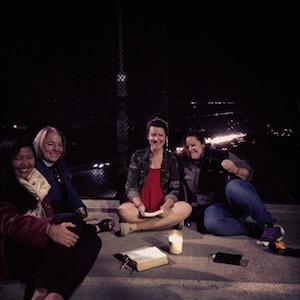Compline: BYO BCP and Flashlight

Students take ancient liturgy into Berkeley during Lent
Earlier this year, two first-year CDSP students—Maggie Foster from the Diocese of Southern Ohio and Spencer Hatcher from the Diocese of Maryland—got to talking about initiatives to bring people into local churches with programs like yoga, community meals, and other non-liturgical events.
“Then we wondered, ‘What would it look like to do the opposite?’ What if we took BCP [the Episcopal Church’s Book of Common Prayer] worship—the core of what we do as Episcopalians—outside?” Foster said.
To answer that question, the two women organized Monday night compline during Lent at six public outdoor locations in Berkeley. Drawing up a flyer that announced “BYO BCP and flashlight,” the pair spread the word to other CDSP students, Episcopal Service Corps interns, local clergy and friends, and L. Ann Hallisey, dean of students.
The group, which ranged between two and twelve people over six weeks, said the final office of the day at Indian Rock Park, the Martin Luther King Park World Wall for Peace, Springer Gateway at the University of California at Berkeley, the downtown Berkeley BART Station, on the Eastshore Footbridge, and at the Berkeley Pier.
“I definitely think the first couple of times it was pretty awkward,” said Hatcher. “There were a couple of times that it was obvious we were in other people’s space doing something that people don’t usually do. Like at Indian Rock, people were in pairs, cuddling, wanting to see the city from above. We weren’t boisterous, and we were really careful not to get too close to people who were already there. But we were praying out loud in unison.”
Another evening, Foster noticed that a group of homeless people nearby stopped talking and became still as they listened to the service.
For her, the sense of bringing compline’s stillness to a busy world was the most enduring part of the experience. “I really realized this as we were praying on the Eastshore Footbridge, which was physically shaking,” she said, referring to the pedestrian walkway that crosses fourteen lanes of I80 near the San Francisco Bay.
“It became about how to bring myself as a contemplative being into a world that is not designed for that type of person,” said Foster. “How do you confront this busy, busy world with prayer and contemplation? I wasn’t setting out to explore that, but it is the question I am left with.”
Although compline is said in all seasons of the liturgical year, for Hatcher, the project was distinctively Lenten. “We were doing something intentional that held us accountable to other people,” she said. “It wasn’t just about Maggie’s and my practice. We set that time apart, held that space regardless of whether other people were coming. We committed to doing it without knowing what the outcome would be.”
“It was very Lenten in that there were times when I was tired or had a paper due, but I had to go,” said Foster.
Although Lent is nearly over, both women say that they want to maintain the practice in Eastertide and take it up again in the next academic year. “We should be doing these things in creation, in beautiful spaces, and in rough spaces,” Hatcher said. “I think a lot of times we create these two extremes: church is in the building, and we are going out serving people. This practice is in between. How can we combine what we do in the church with going out in the world?”

